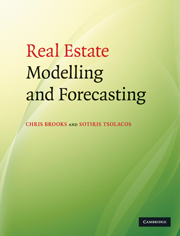Book contents
- Frontmatter
- Contents
- List of figures
- List of tables
- List of boxes
- Preface
- Acknowledgements
- 1 Introduction
- 2 Mathematical building blocks for real estate analysis
- 3 Statistical tools for real estate analysis
- 4 An overview of regression analysis
- 5 Further issues in regression analysis
- 6 Diagnostic testing
- 7 Applications of regression analysis
- 8 Time series models
- 9 Forecast evaluation
- 10 Multi-equation structural models
- 11 Vector autoregressive models
- 12 Cointegration in real estate markets
- 13 Real estate forecasting in practice
- 14 The way forward for real estate modelling and forecasting
- References
- Index
3 - Statistical tools for real estate analysis
Published online by Cambridge University Press: 05 June 2012
- Frontmatter
- Contents
- List of figures
- List of tables
- List of boxes
- Preface
- Acknowledgements
- 1 Introduction
- 2 Mathematical building blocks for real estate analysis
- 3 Statistical tools for real estate analysis
- 4 An overview of regression analysis
- 5 Further issues in regression analysis
- 6 Diagnostic testing
- 7 Applications of regression analysis
- 8 Time series models
- 9 Forecast evaluation
- 10 Multi-equation structural models
- 11 Vector autoregressive models
- 12 Cointegration in real estate markets
- 13 Real estate forecasting in practice
- 14 The way forward for real estate modelling and forecasting
- References
- Index
Summary
Learning outcomes
In this chapter, you will learn how to
contrast time series, cross-sectional and panel data;
calculate measures of central tendency, of dispersion, of skewness and of kurtosis for a given series;
calculate measures of association between series;
test hypotheses about the mean of a series by calculating test statistics and forming confidence intervals;
interpret p-values; and
discuss the most common pitfalls that can occur in the analysis of real estate data.
Types of data for quantitative real estate analysis
There are broadly three types of data that can be employed in quantitative analysis of real estate problems: time series data, cross-sectional data and panel data. Each of these types of data is now described, with examples of how and why they might be used.
Time series data
Time series data, as the name suggests, are data that have been collected over a period of time on one or more variables. Time series data have associated with them a particular frequency of observation or collection of data points. The frequency is simply a measure of the interval over, or the regularity with which, the data are collected or recorded. Box 3.1 shows some examples of time series data.
It is also generally a requirement that all data used in a model be of the same frequency of observation.
- Type
- Chapter
- Information
- Real Estate Modelling and Forecasting , pp. 41 - 71Publisher: Cambridge University PressPrint publication year: 2010



